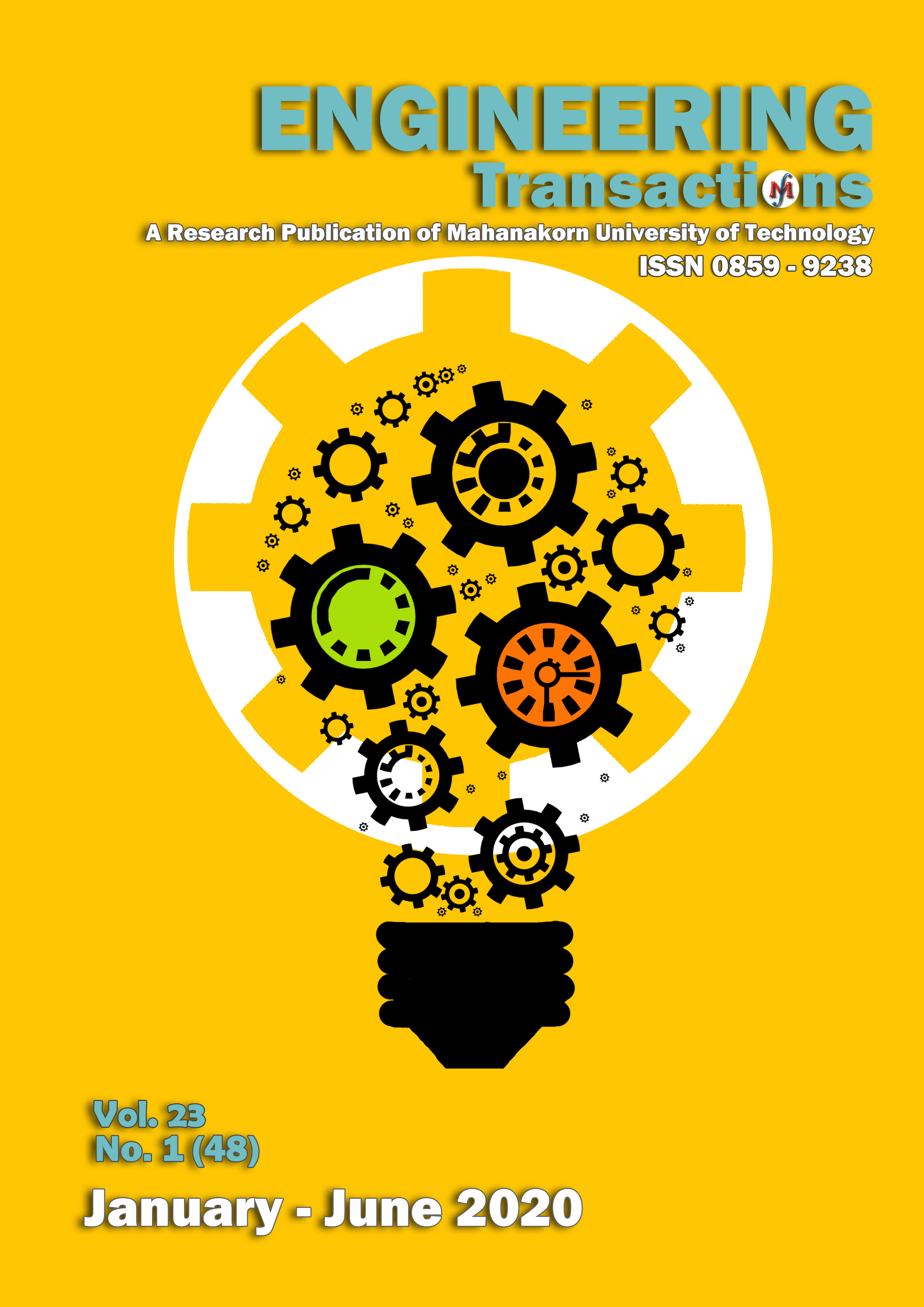Pilot Based Orthogonal Code Channel Estimation for LTE-TDD Massive MIMO Systems
Main Article Content
Abstract
This paper proposes a technique to reduce the effect of pilot contamination in LTE-TDD Massive MIMO Systems. Orthogonal code is modulated with pilot symbol to identify base station (BS). The suboptimal linear LS criterion is applied to BS to estimate channel state information (CSI) and mitigates the pilot contamination in multi-cell scenarios. The simulation results in case of full pilot reuse show that SINR and achievable downlink rate performances obtained from the proposed technique is higher than that of the LS conventional algorithm without BS identity code in fading channel and high cross gain.
Article Details
Copyright @2021 Engineering Transactions
Faculty of Engineering and Technology
Mahanakorn University of Technology
References
T. Rappaport, Wireless Communications: Principles and Practice. Englewood Cliffs, NJ, USA: Prentice-Hall, 1996.
T. Halonen, J. Romero, and J. Melero, Eds., GSM, GPRS and EDGE Performance: Evolution Towards 3G/UMTS. New York, NY, USA: Wiley, 2003
J. G. Andrews, A. Ghosh, and R. Muhamed, Fundamentals of WiMAX. Englewood Cliffs, NJ, USA: Prentice-Hall, 2007.
B. Furht and S. A. Ahson, Eds., “Long Term Evolution: 3GPP LTE Radio and Cellular Technology,” Boca Raton, FL, USA: CRC Press, 2009, ch. 12, pp. 441–443.
S. Sesia, I. Toufik, and M. Baker, Eds., LTE: The UMTS Long Term Evolution. New York, NY, USA: Wiley, 2009.
K. R. Santhi, V. K. Srivastava, G. SenthilKumaran, and A. Butare, ‘‘Goals of true broad band’s wireless next wave (4G–5G),’’ in Proc. IEEE 58th Vehicular Technology Conference, vol. 4. October 2003, pp. 2317–2321.
M. Fallgren et al., Scenarios, Requirements and KPIs for 5G Mobile and Wireless System, document ICT-317669-METIS/D1.1, Apr. 2013.
Industry Proposal for a Public Private Partnership (PPP) in Horizon 2020 (Draft Version 2.1), Horizon 2020 Advanced 5G Network Infrastructure for the Future Internet PPP. [Online]. Available:http://www.networks-etp-eu/fileadmin/user_upload /Home/ draft-PPP-proposal.pdf
F. Rusek et al., ‘‘Scaling up MIMO: Opportunities and challenges with very large arrays,’’ IEEE Signal Processing Magazine, vol. 30, no. 1, pp. 40–60, January 2013.
L. Lu, G. Y. Li, A. L. Swindlehurst, A. Ashikhmin and R. Zhang, “An overview of massive MIMO: Benefits and challenges, ” IEEE Journal of Selected Topics in Signal Processing, vol. 8, no.5 , pp. 742-758, October 2014.
E. G. Larsson, F. Tufvesson, O. Edfors, and T. L. Marzetta, ‘‘Massive MIMO for next generation wireless systems,’’ IEEE Communication Magazine, vol. 52, no. 2, pp. 186–195, Febuary 2014. [Online]. Available: http://arxiv.org/pdf/1304.6690v1.pdf
J. Nam, J.-Y. Ahn, A. Adhikary, and G. Caire, ‘‘Joint spatial division and multiplexing: Realizing massive MIMO gains with limited channel state information,’’ in Proc. IEEE 46th Annual Conference Information Science and Systems (CISS), March 2012, pp. 1–6.
F. Kaltenberger, J. Haiyong, M. Guillaud, and R. Knopp, “Relative channel reciprocity calibration in mimo/tdd systems,” in Proc. Future Network and Mobile Summit, June 2010, pp. 1–10.
H. Bolcskei, R. W. Heath and A. J. Paulraj, “Blind channel identification and equalization in OFDM-based multiantenna systems,“ IEEE Transactions on Signal Processing, vol. 50, no.1 , pp. 96-109, January. 2002.
M. Biguesh,and A. B. Gershman, “Training-based MIMO channel estimation: A study of estimator tradeoffs and optimal training signals,” IEEE Transactions on Signal Processing, vol. 54, no.3 , pp. 884-893, March. 2006.
T. Wo and P. A. Hoeher, “Semi-Blind channel estimation for frequency selective MIMO systems,” in Proc. 14th IST Mobile & Wireless Communications Submmit, Dresden Germany, Junne 2005.
S. Phrompichai and P. Yuvapoositanon, “A semiblind receiver based upon multiple constrained subspace MUD for long-code downlink multirate DS-CDMA systems,” in Proc. International Symposium on Circuits and Systems (ISCAS 2006), 21-24 May 2006.
T. L. Marzetta, “How much training is required for multiuser MIMO,” in Proc. Asiloma Conference on Signals, Systems and Computers, pp. 359-363, October.-November 2006.
S. M. Kay, Fundamentals of statistical signal processing: estimation theory. Prentice-Hall, 1993.
P. Xu, J. Wang, and J. Wang, “Effect of pilot contamination on channel estimation in massive MIMO systems,” in Proc. International Conference on Wireless Communication Signal Processing (ICWCSP), October 2013, pp. 1–6.
3GPP/3GPP2 25.996 v6.1.0 (2003-09), “Spatial channel model for multiple input multiple output (MIMO) simulations (Release6),” in 3GPP, Spatial Channel, 2003.
J. P. Kermoal, L. Schumacher, K. I. Pedersen, P. E. Mogensen and F. Frederiksen, “A Stochastic MIMO radio channel model with experimental validation,” IEEE Jour. on Selected Areas in Communication, vol. 20, no. 6, August 2002.
V Saxena, G Fodor, E Karipidis, “Mitigating pilot contamination by pilot reuse and power control schemes for massive MIMO systems,” in Proc. Vehicular Technology Conference (VTC Spring), May 2015, pp. 1-6.


